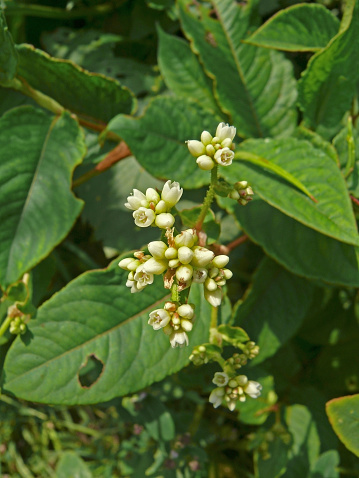

Persicaria chinensis (L.) H.Gross
|
It is commonly known as Jungal palak and belongs to the Polygonaceae family. Leaves and shoots are consumed as vegetable in cooked form. Kaempferol, Quercetin, Isoquercitrin, Luteolin, and Kaempferol-3-galactoside are some of the flavonoids present as bioactive compounds in this plant. Methanolic extract (Pc-ME) inhibited LPS-induced nitric oxide and prostaglandin E2 release by RAW264.7 macro-phages and ameliorated HCl/EtOH-induced gastric ulcers in mice. Mode of Consumption : Boiled or cooked |
| Plant Details | Agro-climatic Zone | Vernacular Names | Pictures |
| Scientific Name: Persicaria chinensis (L.) H.Gross Family: Polygonaceae Juss. Class: Magnoliopsida Order: Caryophyllales Genus: Persicaria Mill. Fruiting Season: June to November (Assam); Throughout the year (Manipur) Parts: Leaves, shoots |
|
Assam : Behu, Kelnap, Wnkham khalai Bihar : Jungal palak Kerala : Nil/ Mudanthi Manipur : Tharak mana Nagaland : Garie Uttar Pradesh : Jungal palak |
 Plant |
| Compound/Extract | Activity | Mode of Action | Marker/References |
| Methanolic extract | Anti-inflammatory | Methanolic extract (Pc-ME) inhibited LPS-induced nitric oxide and prostaglandin E2 release by RAW264.7 macro-phages and ameliorated HCl/EtOH-induced gastric ulcers in mice. The nuclear translocation of NF-κB (p65 and p50) was suppressed by Pc-ME. Methanolic extract (Pc-ME) suppressed production of the inflammatory mediators NO and PGE2, and diminished protein and mRNA expression levels of their genes, iNOS and COX-2, in LPS- or Pam3CSK4-stimulated RAW264.7 cells and LPS treated peritoneal macrophages. | PGE2, NF-κB (p65 and p50), NO, iNOS and COX-2[1] |
| Major Class | Metabolites (Content of bioactives: mg/100g Fresh Weight) |
| Flavonoid | Apigenin + pentose + hexose (C-glycoside): 0.13 ± 0.006 mg/g, Apigenin-7-glucoside: 0.10 ± 0.005 mg/g, Flavone: 0.03 ± 0.001 mg/g, Flavone C-glycoside: 0.11 ± 0.005 mg/g, Flavone glycoside: 2.71 ± 0.130 mg/g, Hyperoside: 0.35 ± 0.02 mg/g, Isoquercitrin: 0.36 ± 0.018 mg/g, Kaempferol: , Kaempferol glycoside: 1.06 ± 0.053 mg/g, Kaempferol-3-galactoside: 0.09 ± 0.004 mg/g, Kaempferol-3-glucoside: 0.13 ± 0.006 mg/g, Kaempferol-3-rhamnoside: 0.15 ± 0.002 mg/g, Kaempferol-3-rhamnoside-7 glucoside: 0.30 ± 0.015 mg/g, Kaempferol-3-rutinoside: 0.31 ± 0.015 mg/g, Kaempferol-3-vicianoside: 0.97 ± 0.050 mg/g, Luteolin: 0.17 ± 0.008 mg/g, Luteolin + glucose + glucuronic acid (C-glycoside): 0.16 ± 0.008 mg/g, Myricetin-3-vicianoside: 0.07 ± 0.003 mg/g, Quercetin + pentose + rhamnose: 0.98 ± 0.049 mg/g, Quercetin glycoside: 0.12 ± 0.006 mg/g, Quercetin-3-vicianoside: 1.54 ± 0.080 mg/g, Quercitrin: 0.50 ± 0.025 mg/g, Rutin: 0.40 ± 0.020 mg/g[2] |
| Phenolic acid | Caffeic acid: [1] |
| Effect | Observation | DOI |
| Disease | Formulation | Reference | Author | TKDL |
| Information from Wealth of India | Reference |
| 4.2, 4.2.1, 4.2.1.1, 4.2.1.3, 4.2.2.8, 4.2, 4.2.1, 4.2.1.1, 4.2.1.3, 4.2.2.8 |
| CSIR-North East Institute of Science and Technology, Jorhat-6, Assam, India
CSIR-Institute of Himalayan Bioresource Technology, Palampur-61,Himachal Pradesh, India |